They spotted another whale carcass off the Jersey Shore yesterday.
Another day. Another dead whale along the US eastern seaboard. Tell me again that this has nothing to do with development and construction of wind turbines. @EcoSenseNow @ShellenbergerMD #climate #energy #windpowerhttps://t.co/kqH2Q9Izm5
— Dr. Matthew M. Wielicki (@MatthewWielicki) February 28, 2023
This one is currently floating in something called the “Ambrose Channel,” just offshore.
A dead humpback whale was seen floating about 4 or 5 miles off the New York-New Jersey coastline Monday, federal officials confirmed.
The 9th carcass, another humpback, washed ashore near Manasquan on the 15th of this month…
A ninth dead whale has washed up on the New Jersey coastline, as conservationists and local authorities investigate the causes of an unusual number of such deaths along the US east coast.
…The whale was removed from the beach on Tuesday and taken to the county landfill for a necropsy and to collect tissue samples, a spokesperson for Noaa Fisheries, part of the National Oceanographic and Atmospheric Administration, told Gothamist.
…and the 10th was found two days later on Rockaway Beach in Queens, NY, which is right on the NJ/NY border. Unlike many of the others, though, this little minke whale did have significant head trauma, so looked like a pretty solid boat-strike cause of death.
At the rate 2023 is starting off – and the way 2022 finished – it could be a grim year for whales in the Mid-Atlantic.
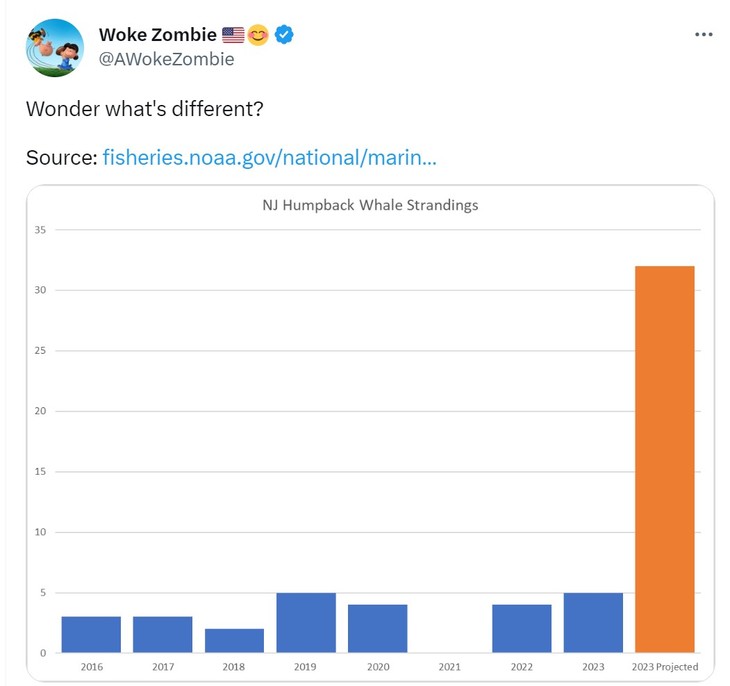
According to the NY Times, a rebounding marine mammal population and your Amazon habit are to blame for killing unprecedented numbers of whales.
Twenty-three dead whales have washed ashore along the U.S. East Coast since early December, including 12 in New Jersey and New York, officials say.
Factors including climate change and online shopping appear to be at least partially to blame. https://t.co/zm1LiDKu5r
— The New York Times (@nytimes) February 28, 2023
…In all, 23 dead whales have washed ashore along the East Coast since early December, including 12 in New Jersey and New York, according to the National Oceanic and Atmospheric Administration. The pace of the deaths is worrisome to federal scientists, even if the total numbers are below some prior years.
…The population of humpbacks, hunted legally until 1985, has rebounded, thanks in part to decades of efforts to clean the Atlantic Ocean and heavily polluted tributaries like the Hudson River. As the climate changes and oceans warm, whales and a favored prey, menhaden, are migrating and feeding in new locations, often closer to shore.
Online pandemic buying habits are also fueling a record-setting surge in cargo shipments that last year made ports in New York and New Jersey the nation’s busiest. Much of the merchandise is now toted on far bigger ships — some of which have altered their routes to help alleviate the supply-chain chaos that last year left some store shelves bare.
As a result, more whales appear to have found themselves in the direct path of more ships.
It’s not surprising that a rag as heavily invested in the renewable scheme as the NYT would head off questioning the impact a trio of massive wind projects in various stages of development just off the NY and NJ coasts are having. Way down in the article, they offer a couple of paragraphs as a salve to critics of the projects but they make sure to end with a strong finish about how most environmentalists are all in on wind power.
The NYT view stands in pretty stark contrast to alarmed local NJ mayors, town councilmen, and even their Congressmen, who want a pause until they can figure out exactly what is going on.
…Rep. Chris Smith, R-N.J., who represents a district along the Atlantic coast, introduced legislation Friday that would mandate a federal investigation into the role wind energy development may have played in the recent uptick in whale deaths.
Smith’s bill would require immediate, comprehensive investigation into the environmental approval process for offshore wind projects. According to the New Jersey lawmaker, Biden administration officials have ignored his calls for an investigation into the matter and for a moratorium on offshore wind development until the cause of the whale deaths was conclusively determined.
“Nine dead whales have washed up on our beaches since early December, and we still have no meaningful answers from Governor Murphy or the Biden Administration on the broader impact of these projects on the marine environment as they rush to build the largest offshore wind farm in the nation,” Smith said in a statement.
In fact, even a member of the Biden administration at NOAA had his doubts about pressing forward and wrote a warning memo to colleagues last year.
A senior Biden administration scientist authored an internal memo warning of the impacts offshore wind development may have on marine life months before the recent spate of whale deaths along the East Coast.
Sean Hayes, the National Oceanic and Atmospheric Administration’s (NOAA) chief of protected species, penned the memo in May 2022 and sent it to Bureau of Ocean Energy Management (BOEM) lead biologist Brian Hooker, also copying more than a dozen other scientists from the two agencies. The memo highlighted Hayes’ concerns about how offshore wind construction and surveying could disrupt the endangered Atlantic right whale.
“The development of offshore wind poses risks to these species, which is magnified in southern New England waters due to species abundance and distribution,” Hayes wrote in the letter dated May 13. “These risks occur at varying stages, including construction and development, and include increased noise, vessel traffic, habitat modifications, water withdrawals associated with certain substations.”
“The focus of this memo is on operational effects, and as such, focuses on potential oceanographic impacts driving right whale prey distribution, but also acknowledges increased risks due to increased vessel traffic and noise,” he continued. “However, unlike vessel traffic and noise, which can be mitigated to some extent, oceanographic impacts from installed and operating turbines cannot be mitigated for the 30-year lifespan of the project, unless they are decommissioned.”
Why are environmental voices being ignored? Is it because they’re on the wrong side of the dollar equation and brave new world they want us forced into?
…”Dead whales and tough economics bedevil Biden’s massive wind energy push,” the Post wrote. “Achieving the Biden administration’s target would require the installation of thousands of the machines, which will tower as high as three Statues of Liberty stacked on top of one another when their blades reach for the sky… The blades alone can be the length of a football field.”
The Post also noted, while there is a debate over whether the turbines impact whales, many are condemning such efforts.
“We have an unprecedented amount of whales dying here at the same time there is this industrial activity taking place on a scale that has never before happened in these waters,” Cindy Zipf, executive director of Clean Ocean Action, told the Post. “Why is this not being investigated?
Why are these companies getting a pass?”
Why are they? This tweet piqued my interest.
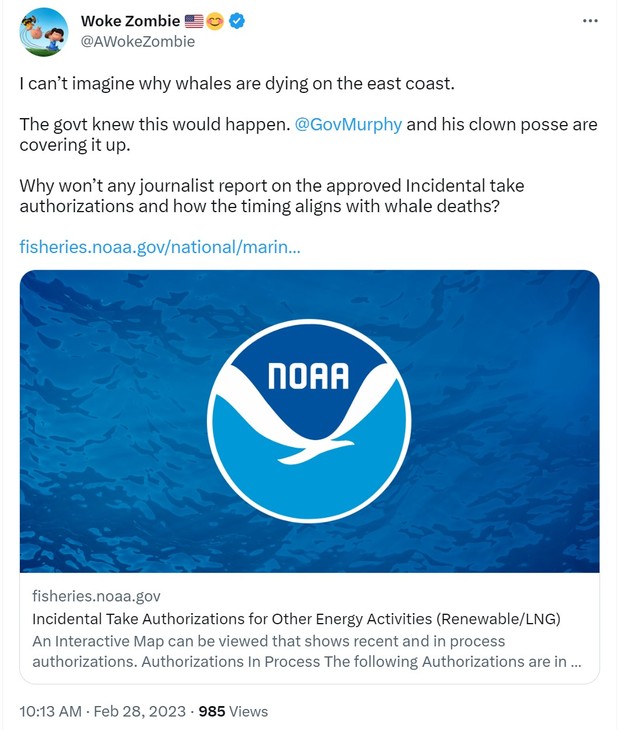
The companies might also be “getting a pass” because the government has already given them tacit permission for the deaths.
What he’s referring to with “incidental take” is the number of dead animals who just happen to be killed in the course of building out these projects. It’s a much neater way for the government to say, “kill quotient.”
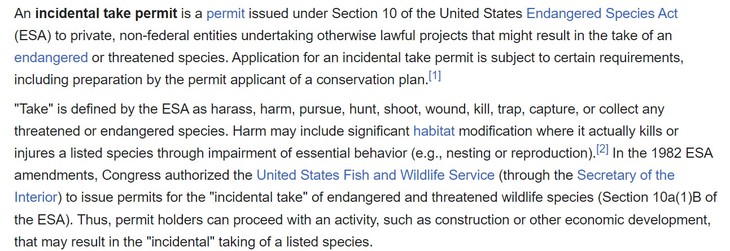
The companies are required to do species population surveys and estimates, then determine how each of the different phases of the project will adversely affect each species, and what the possible mortality figure – or incidental take – will be. They then present their research and estimates to the government for a blessing letter of approval: yea or nay they may kill, maim and disturb that many animals.
Each phase includes the pre-construction sonar and seismic survey work, and then the construction mayhem from there forward. They are already doing the first phase.
This is the document file the Ocean Wind project (that’s the one off the south NJ coast) submitted to the National Marine Fisheries Office of Protected Resources for approval. It’s filled with a plethora of charts and research and guesstimates, and I haven’t had time – and frankly, don’t have all the skillset – to tear into the minutia. But the plain language summaries are pretty simple to parse. The last chart is the estimated 5 year “incidental take” total, by species, that the government signed off on.
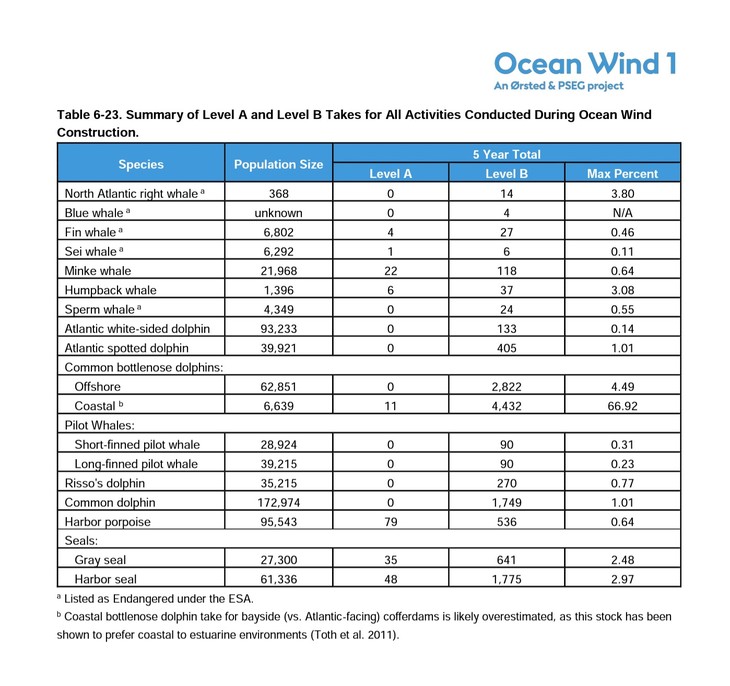
Those are some honkin’ huge numbers. Are we already seeing the effects washing ashore? Is it at all possible that the pounding away on the ocean bottom with sonar is driving the whales closer to shore/NYC-bound shipping channels? Perhaps they can’t hear the boats over the sonar. Are they trying to get around the noise that is so disorienting to them (more so to some species than others, as well) and that’s why they’re getting whapped on the gourd, where they might otherwise not be in the channels anywhere near those numbers?
Why can’t we ask that? Or any of these questions?
Where are all the big environmental groups? All the WEF “We must save Gaia” crusaders?
Tell you what – it’s a shame whales can’t wear felt and herd reindeer.
Greta Thunberg joined Indigenous Sámi people in Norway protesting wind farms built on their land, calling them “cover for colonialism.”
A court ruled against the turbines in 2021.
Sámi people have faced oppression and use the land to herd reindeer, a major source of livelihood. pic.twitter.com/2p3oznb5tL
— AJ+ (@ajplus) February 28, 2023
At least they’d get their day in court.
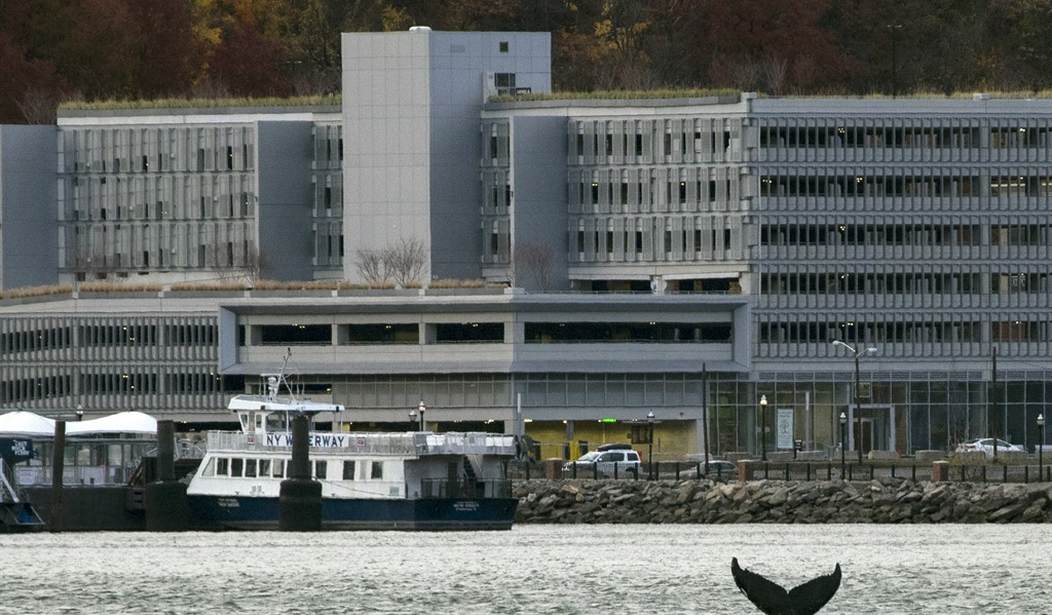






Join the conversation as a VIP Member